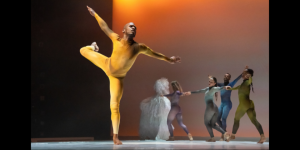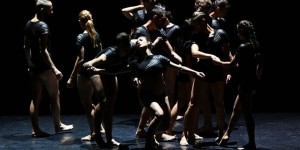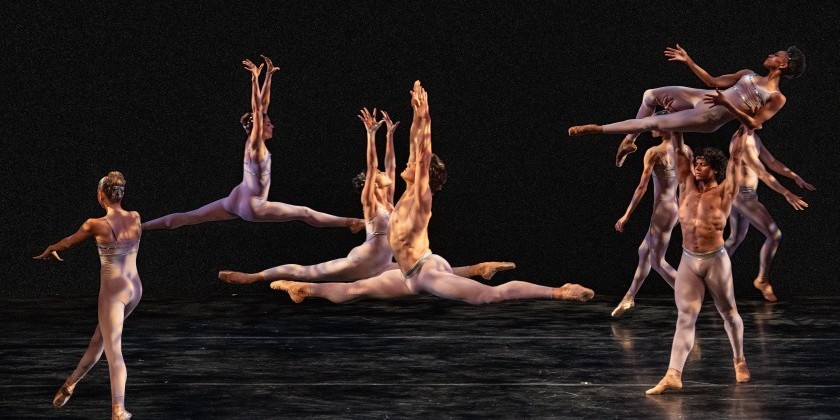IMPRESSIONS: Adriana Pierce's #QueertheBallet Company Presented by The Joyce Theater at Chelsea Factory

Choreography: Adriana Pierce and Lenai Alexis Wilkerson
Performers: Sierra Armstrong, Felix Bryan, Naomi Corti, Cortney Taylor Key, Fleming Lomax, Miriam Miller, Adriana Pierce, Devon Teuscher, Lenai Alexis Wilkerson, and Remy Yong
It's 2022, and in many disciplines, artists find themselves questioning traditional gender roles. But what about classical ballet? One often wonders if the genre is permanently frozen in an age where strong men lift tutu-clad women. Adriana Pierce, formerly of Miami City Ballet, founded #QueertheBallet to challenge the antiquated gender narratives still perpetuated in the ballet world. The simmerings of #QueertheBallet began during the pandemic, when Pierce gathered queer women and non-binary dancers on Zoom to promote a sense of belonging and appreciation of their shared experience.
#QueertheBallet was presented by the Joyce Theater, in partnership with Chelsea Factory. At their newly opened multidisciplinary arts space in West Chelsea — a historic building that once housed New York City’s first fleet of taxis— the partners aim to support artists from underrepresented communities and to inspire connection, inspiration and joy.
Overlook, which opens the evening, finds American Ballet Theatre dancers, Sierra Armstrong and Remy Young, both en pointe, partnering one another. Their shared vulnerability contrasts the typical power balance of a man supporting a woman. As the couple trace a serpentine pattern upstage, weaving toward a purple scrim, their graceful movement is punctuated by unconcealed intimacy. When one woman resolutely places her hand in the other’s, we feel the tenderness and mutual support of lovers
In Brick by Brick, five dancers construct, then dissolve out of, physical formations. Acting as human building blocks, they strive to make the stage a safe place. In a post performance panel discussion, the dancers spoke of the stage being an inherently holy area, similar to a church (though churches have not historically been safe places for LGBTQ+persons.)
Lenai Alexis Wilkerson’s self-performed Q.U.E.E.R was the most memorable piece of the evening. Wilkerson, a captivating performer, possesses a fierce stage presence coupled with expressive vulnerability. Moments of technical virtuosity, like a perfectly executed triple pirouette, contrast with the emotive gestures of her arms and chest. As Q.U.E.E.R's music concludes, Wilkerson walks towards the audience surrounded by powerful aura of self acceptance that resonates throughout the theater.
The closing work, a solo choreographed and performed by Pierce, is set to queer icon Brandi Carlile’s Party of One. The dance explores the theme of finding power solitude.
During the evening each choreography blends into the other. Sometimes it was difficult to tell where one dance ended and the other began. At moments, the work, and the last piece in particular, felt overly simple, even obvious. Yet there was something refreshing about the purity of emotion which shone through.
Works of film accompany also accompanied the dancing. The first film, by Alejandro Gonzalvez, focused on solo women dancing in studios and in nature, highlighting the singularity of their movement qualities and vocabularies. The second, Rachel Malehorn’s Uptake, featured two women dancing together on a cliff, overlooking the ocean, beside them a partially constructed fort made of sticks and translucent fabric. Following Brick by Brick, Uptake carried forward the theme of women collaborating to create safe physical and metaphorical spaces.
Pierce, who choreographed the majority of works presented, recalls the isolation she experienced in her career as a classical ballet dancer. Her company, devoted as much to what happens offstage as to live performance, aims to educate audiences about queer experiences and narratives. Their hope is to shift perspectives and provoke conversation and awareness.
#QueertheBallet is certainly not the first dance company to scrutinize gender narratives or attempt to re-imagine classical ballet. Ballets Trockadero, the iconic all-male ballet company, has been cheekily and flamboyantly challenging gender roles since 1974 in response to the Stonewall Riots. BALLEZ’s Katy Pyle began taking on the canon of classical ballet, in 2011, defying the genre’s “racist, cis-hetero, patriarchal lineage.”
Whereas the word “queer” seems iconoclastic, #QueertheBallet feels anything but rebellious. Perhaps more liberating and self-actualizing, here queer artists move simply as themselves. And maybe that, in itself, is revolutionary.









![IMPRESSIONS: Will Rawls' “[siccer]” at the Keith Haring Theatre at Performance Space New York](/images/features_large/20251119_WillRawls_siccer_PerformanceSpaceNY_WhitneyBrowne--55.jpg)


